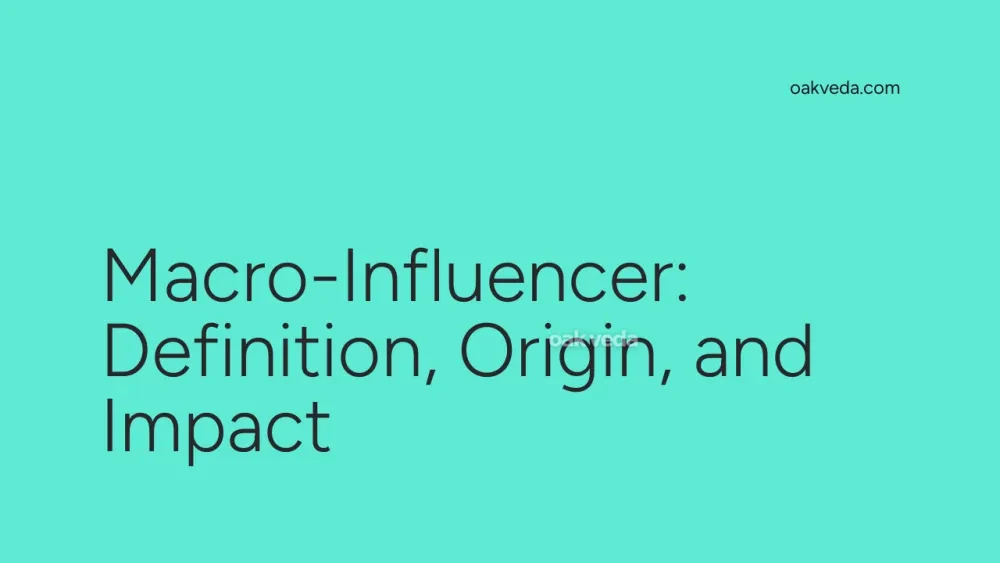
What is a Macro-Influencer?
A macro-influencer is a social media personality with a substantial following, typically ranging from 500,000 to 1 million followers on a single platform. These individuals have cultivated a significant presence in their niche, whether it's fashion, beauty, lifestyle, fitness, or technology. Macro-influencers occupy a unique position in the social media landscape, bridging the gap between everyday content creators and celebrity endorsers.
Origin and Development of Macro-Influencers
The concept of macro-influencers emerged as social media platforms matured and user bases grew exponentially. In the early 2010s, as platforms like Instagram, YouTube, and Twitter gained popularity, certain users began to amass large followings due to their content quality, personality, or expertise in specific areas. This organic growth led to the recognition of influencer marketing as a powerful tool for brands to reach engaged audiences.
How Macro-Influencers Work
Macro-influencers operate by creating high-quality, engaging content that resonates with their audience. They often specialize in a particular niche, allowing them to build authority and trust within their community. These influencers leverage various social media features, such as:
- Regular posts and stories
- Live streaming
- Hashtag campaigns
- Collaborations with brands and other influencers
Their large following enables them to generate significant exposure for products, services, or causes they promote, making them attractive partners for brands seeking to expand their reach.
Types of Macro-Influencers
While macro-influencers are defined by their follower count, they can be further categorized based on their content focus:
- Lifestyle Macro-Influencers: Share content about their daily lives, personal style, and experiences.
- Niche Experts: Focus on specific topics like tech reviews, cooking, or fitness.
- Content Creators: Produce high-quality videos, photos, or written content in their area of expertise.
- Thought Leaders: Offer insights and opinions on industry trends or social issues.
Popular Examples of Macro-Influencers
Some well-known macro-influencers across various platforms include:
- Kayla Itsines (fitness)
- Marques Brownlee (tech reviews)
- Chiara Ferragni (fashion)
- Zach King (visual effects and magic tricks)
These influencers have built their brands through consistent, high-quality content and strong audience engagement.
Impact of Macro-Influencers on Social Media Culture
Macro-influencers have significantly shaped social media culture by:
- Setting trends in fashion, beauty, and lifestyle choices
- Influencing purchasing decisions through product recommendations
- Raising awareness about social and environmental issues
- Changing the way brands approach marketing and customer engagement
Their ability to connect with audiences on a personal level while maintaining a broad reach has made them powerful voices in the digital space.
Controversies Surrounding Macro-Influencers
Despite their popularity, macro-influencers face several challenges and controversies:
- Authenticity concerns: As influencers grow their following, maintaining authenticity can become challenging, leading to skepticism from audiences.
- Disclosure issues: Proper disclosure of sponsored content has been a recurring issue, leading to increased scrutiny from regulatory bodies.
- Mental health impacts: The pressure to maintain a perfect image and constantly produce content can take a toll on influencers' mental health.
- Follower fraud: Some influencers have been accused of artificially inflating their follower counts, leading to trust issues with brands and audiences.
How Brands and Influencers Use Macro-Influencers
Brands leverage macro-influencers in various ways:
- Sponsored posts: Influencers create content featuring the brand's products or services.
- Brand ambassadorships: Long-term partnerships where influencers become the face of a brand.
- Product collaborations: Co-creating products that blend the influencer's personal brand with the company's offerings.
- Event promotions: Influencers attend and promote brand events to their followers.
Macro-influencers, in turn, benefit from these partnerships through:
- Monetary compensation
- Free products or services
- Increased exposure and credibility
- Opportunities for business growth and diversification
Future Trends Related to Macro-Influencers
The landscape of influencer marketing is continually evolving. Some emerging trends include:
- Increased focus on micro and nano-influencers: Brands are recognizing the value of smaller, highly engaged audiences.
- Video-first content: With the rise of TikTok and Instagram Reels, short-form video content is becoming increasingly important.
- Authenticity and transparency: Audiences are demanding more genuine, unfiltered content from influencers.
- Social commerce integration: Platforms are introducing features that allow influencers to sell products directly through their content.
- Virtual influencers: Computer-generated personalities are gaining traction, offering brands new avenues for partnerships.
FAQs about Macro-Influencers
-
How much do macro-influencers charge for sponsored posts? Rates vary widely but can range from $5,000 to $10,000 per post, depending on the platform and engagement rates.
-
Are macro-influencers more effective than micro-influencers? It depends on the campaign goals. Macro-influencers offer broader reach, while micro-influencers often have higher engagement rates and niche audiences.
-
How do brands measure the success of macro-influencer campaigns? Key metrics include engagement rates, reach, impressions, click-through rates, and conversions.
-
Can anyone become a macro-influencer? While anyone can potentially grow a large following, it requires consistent high-quality content, strategic networking, and often a unique angle or expertise.
-
How do macro-influencers maintain their following? By consistently producing engaging content, interacting with their audience, and staying authentic to their personal brand.
In conclusion, macro-influencers play a significant role in shaping social media trends and consumer behavior. As the digital landscape continues to evolve, their impact on marketing strategies and brand-consumer relationships is likely to remain substantial, albeit with increasing emphasis on authenticity and measurable results.
You may be interested in:
- Vibe Check: Definition, Origin, and Impact on Social Media
- Camp in Social Media: Definition, Origin, and Impact
- Bestie: Definition, Origin, and Impact on Social Media
- SEO: Definition, Origin, and Impact on Digital Marketing
- Spamming on Social Media: Definition, Origin, and Impact
- Glow-Down: Definition, Origin, and Impact on Social Media

